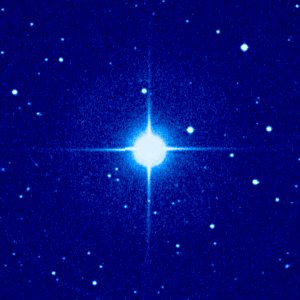Credit & Copyright: Royal
Observatory Edinburgh, Anglo-Australian Observatory, and AURA
Explanation:
Are we alone in the
universe? Do other
stars have
planets too? Humanity
took one step closer to answering these questions in October 1995 when it
was announced that the star
51 Pegasi harbors at least
one planet. In the above picture of
51 Peg the planet
is not visible - it can only be detected by noticing small changes in the
star's motion.
Claims of planets
orbiting other
stars are rare, with
perhaps the most credible pertaining to a
neutron star - a star much
different than the
Sun. But new ground was broken when the planetary
detection claimed around the normal Sun-like star 51 Peg was confirmed. The
planet, discovered by Michel Mayor and Didier Queloz, is thought to be like
Jupiter - except orbiting so close to the parent
star that it's year lasts only about 4 days! In the above picture the
lines centered on 51 Peg are caused by the telescope itself and are not
related to the star or planet.
1999 2000 2001 2002 2003 2004 2005 2006 2007 2008 2009 2010 2011 2012 2013 2014 2015 2016 2017 2018 2019 2020 2021 2022 2023 2024 2025 |
Январь Февраль Март Апрель Май Июнь Июль Август Сентябрь Октябрь Ноябрь Декабрь |
NASA Web Site Statements, Warnings, and Disclaimers
NASA Official: Jay Norris. Specific rights apply.
A service of: LHEA at NASA / GSFC
& Michigan Tech. U.
|
Публикации с ключевыми словами:
planet - Планета-гигант - Планеты у других звезд
Публикации со словами: planet - Планета-гигант - Планеты у других звезд | |
См. также:
Все публикации на ту же тему >> | |
